San Pedro de Atacama
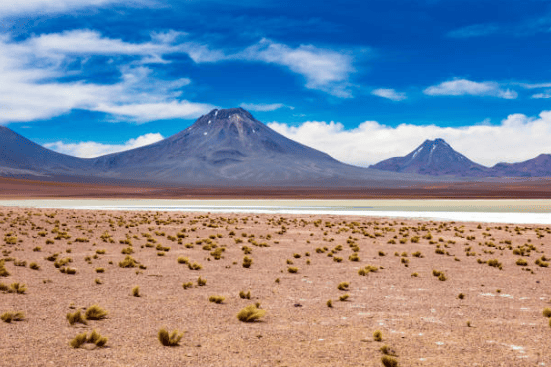
San Pedro de Atacama is a fascinating and unique travel destination that many may not know about. Even I hadn’t heard of it until a Chilean friend recommended it to me. Yes, San Pedro de Atacama is in Chile, South America.
As one of Chile’s popular tourist spots—alongside Rapa Nui National Park on Easter Island, Valparaíso, and Torres del Paine—San Pedro de Atacama is already well-known among travelers from the Americas and Europe.
I had the opportunity to visit San Pedro de Atacama during my one-and-a-half-month adventure in South America. From Santiago, Chile’s capital, I took a bus to San Pedro de Atacama.
This was my first experience traveling overland for more than a thousand kilometers, taking nearly 24 hours. The bus left around 10 a.m. and arrived in San Pedro de Atacama the next morning at 9 a.m., so I slept on the bus.
As I arrived and looked out from the bus, I felt like I was on another planet. The scenery reminded me of Mars and the moon’s surface up close. In fact, San Pedro de Atacama is known as one of the places on Earth most similar to Mars.
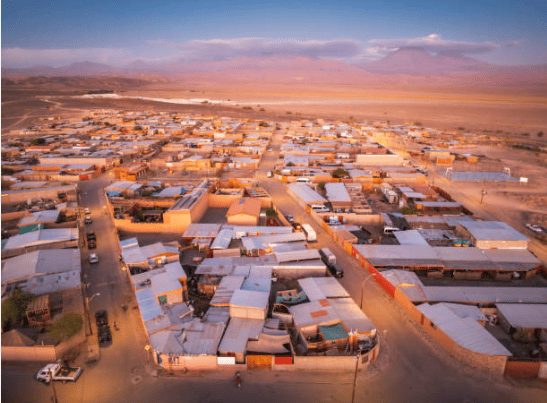
Established in 1540, San Pedro de Atacama lies in the vast Atacama Desert, on the high plains to the west of the Andes, facing the Licancabur volcano.
The Atacama Desert is known as the driest desert in the world, with almost no rainfall. As far as the eye can see, it’s a barren landscape of rock and sand. When cars pass, dust rises, and not all roads are paved.
The town’s roads were even rougher, mostly unpaved except for the main road. Despite being called a “town,” San Pedro de Atacama felt more like a village. Its small residential area can be explored in about an hour on foot.
Visiting in March, I experienced summer, the peak tourist season. The days were scorching, but once the sun began to set, the temperature dropped drastically.
Arriving early, with hours until check-in, I waited at the small bus terminal for breakfast—a chance to try San Pedro de Atacama’s local food for the first time. After eating and as the temperature warmed, I headed to my hostel to drop off my backpack.
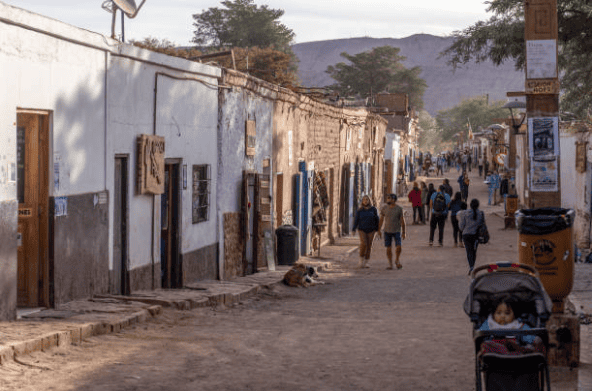
The hostel was close to the terminal and easy to find. Most tourists walk in this “village,” with a few on bicycles and hardly any cars around. Dust flew up whenever a car passed by, and I couldn’t avoid it, ending up with a mouthful of dust.
At the hostel, I was greeted by a friendly foreign receptionist who let me register and relax in the lobby. They even allowed me to use the internet to research places to visit. After reading a few articles, I left my backpack and went exploring San Pedro de Atacama.
My first stop was Plaza de San Pedro de Atacama. I imagined a spacious, bustling square, but it turned out to be no larger than a quarter of a soccer field.
Next to it was the unique Iglesia San Pedro, an old adobe church with an earthy red color, blending naturally with the landscape. Nearby were restaurants, cafes, souvenir shops, and a small market. From the plaza, I wandered through the “village,” seeing tourists everywhere, mostly on foot like me.
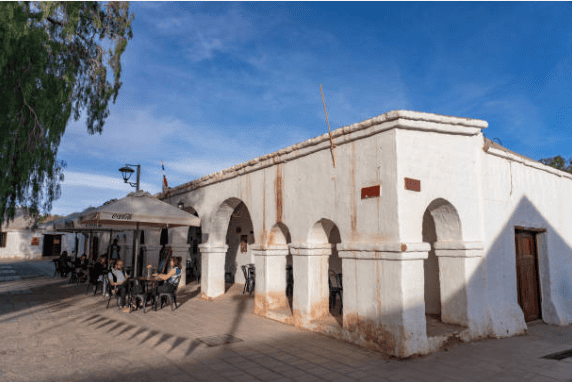
There were no tall buildings here, everything was simple, with older structures preserved in reddish-brown clay, even hotels and hostels like mine, which looked more like humble shacks.
There isn’t much to see in the town itself, but it serves as a gathering spot for tourists looking to explore the natural wonders of San Pedro de Atacama—a place to rest and grab a coffee after an adventure. For me, though, it was fascinating to see the local people and the distinctive Atacama architecture, made from clay and wood.
After an hour of exploring, I returned to the hostel. Before heading back, I bought groceries to cook, finding plenty of eggs, potatoes, and vegetables, just like shopping in a local store back home. Thankfully, the hostel had a kitchen, so I opted to cook instead of eating at a pricey restaurant.
Tourist Attractions Around San Pedro de Atacama
Most attractions near San Pedro de Atacama are quite a distance from the town center. To make things more complicated, there’s no public transport here, so renting a car or jeep is necessary—and not cheap, especially if you’re traveling alone. I tried finding someone to split costs with via Couchsurfing.
I connected with another traveler also looking for a cost-sharing companion to explore some of these attractions. We registered ourselves and another person, but by the next day, no more participants joined, and the plan was ultimately canceled. I still hoped to find someone to share costs.
The attractions around San Pedro de Atacama are almost entirely natural wonders, including the Los Flamencos National Reserve, the Toconao oasis, the Atacama Salt Flat, Pukará de Quitor, and Aldea de Tulor, which is just three kilometers outside San Pedro.
Other notable spots include the Tatio Geysers, Puritama Hot Springs, Jere Valley (Quebrada de Jere), Salt Mountain Range, Death Valley, and Moon Valley, only 6 kilometers from San Pedro. There’s also the Hidden Lagoons of Baltinache, about 41 miles south of San Pedro.
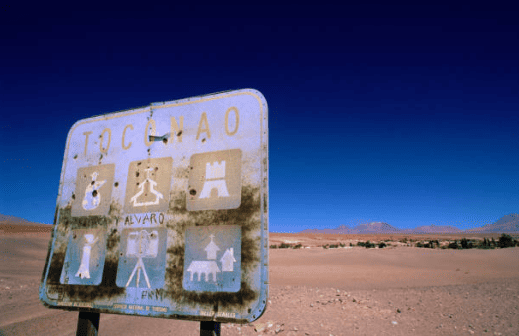
As time passed without finding a cost-sharing partner, I decided to visit Toconao, a village in the middle of the desert located 38 kilometers southeast of San Pedro de Atacama. It’s the only nearby village connected to San Pedro by public bus.
Before heading there, I asked the hostel receptionist for bus schedules. On my last day in San Pedro de Atacama, I took an early bus to Toconao, checking the last return schedule to ensure I wouldn’t miss it.
During the ride, the landscape was mostly desert, with occasional patches of marshland and a distant white expanse resembling salt. The Andes Mountains formed a scenic backdrop, with snowy peaks reminiscent of Mount Fuji in Japan.
After a 30-minute ride, I arrived in Toconao, an oasis village known for its traditional architecture built from volcanic rhyolite stone and its church and bell tower, constructed by the Spanish in the mid-18th century.
Toconao is also a gateway to Chaxa Lagoon in the Soncor sector of the Los Flamencos National Reserve. Although it’s close to the lagoon, I only had time to explore Toconao. I wandered around, taking in the tranquil atmosphere.
The village was peaceful, with few tourists around, and I saw few locals as well. From the main road, I headed straight to the old church, a Toconao landmark dating back to 1750. It’s a modest structure with a separate bell tower.
Being the only visitor, I took my time exploring and taking photos. In front of the church, there’s a gazebo where I rested and had a drink. Then I continued exploring the village until midday, heading toward the desert to see the salt flats in the distance and hoping to spot some flamingos.
In the afternoon, I crossed over to Jere Valley, just next to Toconao. This rare agricultural area in the Atacama Desert is an oasis created by streams flowing down from the Andes, supplying water to both the Atacama Salt Flat and Toconao.

The small valley, surrounded by desert and rugged cliffs, was fascinating, but I didn’t linger too long. I returned to the main road, capturing photos of the empty landscape.
Afterward, I went to a shop selling bus tickets back to San Pedro de Atacama. Since the last bus was still two hours away, I relaxed near the Toconao Bell Tower. Around the small church, there were local shops selling crafts, so I browsed around until it was time to head back.

It抯 in reality a great and useful piece of info. I抦 satisfied that you shared this helpful information with us. Please keep us up to date like this. Thank you for sharing.
You helped me a lot with this post. http://www.kayswell.com I love the subject and I hope you continue to write excellent articles like this.
Your articles are very helpful to me. May I request more information? http://www.kayswell.com
You helped me a lot by posting this article and I love what I’m learning. http://www.kayswell.com
May I have information on the topic of your article? http://www.kayswell.com
Awesome site you have here but I was wanting to know if you knew of any user discussion forums that cover the same topics talked about in this article? I’d really love to be a part of online community where I can get feedback from other knowledgeable individuals that share the same interest. If you have any recommendations, please let me know. Thanks!
I would also like to add that in case you do not already have got an insurance policy or else you do not form part of any group insurance, you could possibly well make use of seeking aid from a health insurance broker. Self-employed or those that have medical conditions typically seek the help of one health insurance brokerage service. Thanks for your short article.
Your articles are extremely helpful to me. Please provide more information! http://www.kayswell.com
I’d like to find out more? I’d love to find out more details. http://www.hairstylesvip.com
Great beat ! I would like to apprentice while you amend your web site, http://www.hairstylesvip.com how could i subscribe for a blog site? The account helped me a acceptable deal. I had been a little bit acquainted of this your broadcast provided bright clear concept
The articles you write help me a lot and I like the topic http://www.kayswell.com
Thank you for your articles. They are very helpful to me. May I ask you a question? http://www.kayswell.com
I enjoyed reading your piece and it provided me with a lot of value. http://www.kayswell.com
I’d like to find out more? I’d love to find out more details. http://www.kayswell.com